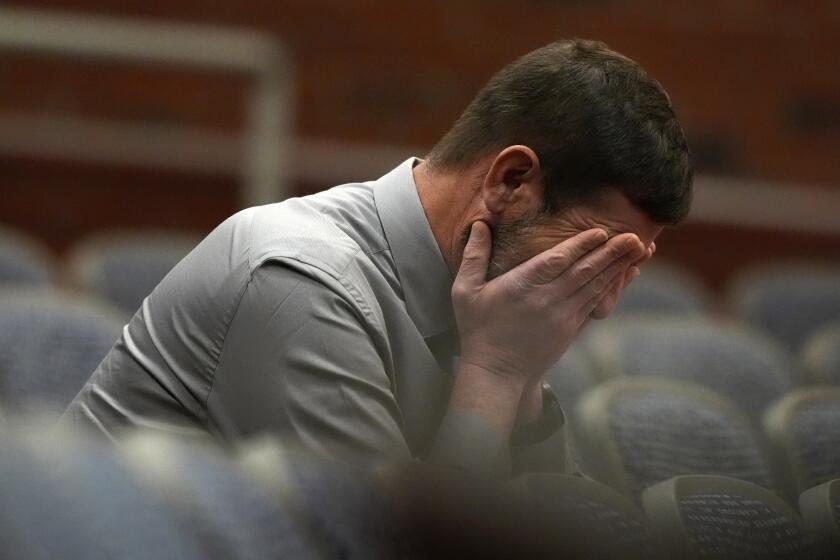4 Britons Suspected in Blasts
Four men identified as suspects in last week’s London bombings probably died in the attacks, police said Tuesday, raising fears that suicide bombings have now taken root in Europe.
The four, believed to be Britons of Pakistani descent, were seen on security videotape footage together at the King’s Cross rail station about 20 minutes before three of the bombs exploded almost simultaneously on subway cars that had left the busy station. The video reportedly showed that each man carried a rucksack.
Personal documents belonging to three of the men later were found at three blast sites, police said.
On Tuesday, police raided six residences in the Yorkshire region, including the homes of three bombing suspects. Officers seized evidence, destroyed explosives found at two sites and arrested one man.
Police evacuated 500 to 600 residents from a neighborhood in the Yorkshire city of Leeds and then carried out a controlled blast. The area was believed to have been the site of the attackers’ bomb-making facility. Early today, the residents still had not been allowed back into their homes.
Police also sealed off a train station in Luton, 30 miles north of London, after finding a parked vehicle there believed to be connected to the suspects. The car was later found to contain explosives, which were destroyed. Two other suspicious parked cars were also being examined for evidence.
The disclosures and sweep followed five days of investigation during which officials gave little hint of progress in identifying or apprehending those responsible for Thursday’s attacks, which killed at least 52 people along three subway lines and aboard a double-decker bus.
The bus bomb exploded at Tavistock Square at 9:47 a.m., nearly an hour after the other blasts. That time lapse has raised speculation that the bomber had been evacuated from the Underground along with other travelers after the first three explosions. It remained unclear whether his bomb went off intentionally or accidentally.
A crucial break in the case may have come from the family of one of the suspects, who reported him missing to the Central Casualty Bureau on Thursday after the attacks.
“We have now been able to establish that he was joined on his journey to London by three other men,” said Peter Clarke, anti-terrorism chief with London’s Metropolitan Police.
“We now know that all four of these men arrived in London by train on the morning of Thursday, July 7,” Clarke said. “We have identified CCTV footage showing the four men at King’s Cross Station shortly before 8:30 a.m. on that morning.
“We have since found personal documents bearing the names of three of those four men close to the seats of three of the explosions,” Clarke said. “As regards the man who was reported missing, some of his property was found on the Route 30 bus in Tavistock Square.”
The four suspects were believed to be Britons whose families came from Pakistan, a Spanish intelligence official said.
British media have reported in recent days that investigators found forensic evidence at the Tavistock Square site that suggested the possibility of a suicide bombing.
Clarke also said police had “very strong forensic and other evidence” that another suspect had died in the explosion near the Aldgate subway station. One police source later clarified that the evidence was body parts found at the Underground blast scene. The official also intimated that confirmation of the deaths of at least two of the three subway bombers was expected as soon as pathologists could match DNA samples to remains.
Neighbors in Leeds identified one of the suspects as Shahzad Tanweer. They said they thought he was a university student in his early 20s and described him as an average young man who played soccer and cricket. His family owns several small businesses.
ITV news quoted an unnamed neighbor as saying that Tanweer had spent six months last year in Afghanistan and Pakistan, where some European jihadis still travel for training despite the destruction of Al Qaeda camps in Afghanistan in late 2001.
Officials declined to answer other questions about the investigation and gave no details of any significant evidence that might have been found at the site of the blast aboard a train on the Piccadilly Line as it neared Russell Square Station. That might be because most evidence was obliterated in the blast, the most destructive of the four. At least 24 people died in the explosion.
Police also gave no details of the man arrested except to say he would be brought to London for interrogation.
As evidence increasingly pointed to a carefully synchronized attack with high explosives, it seemed likely that the bombings marked a grim milestone in the history of terrorism in Western Europe: the continent’s first successful suicide bombing. That would realize the worst fears of European anti-terrorism chiefs, who said Islamic terrorists had opened a new and ominous phase in their campaign.
“If it is confirmed, it’s not good news,” said Stefano Dambruoso, a former top anti-terrorism prosecutor who is now Italy’s judicial attache to the United Nations in Vienna. “It marks the beginning of a new era. Because we cannot delude ourselves. Europe is really a land of jihad in the full meaning of the term.”
Many law enforcement officials in Europe have conceded they were surprised they had been able to thwart suicide attacks on their home turf so far. There have been several close calls, notably the attempt by Briton Richard Reid, known as the “shoe bomber,” to ignite explosives packed into his basketball shoes aboard a Paris-Miami flight in December 2001.
Anti-terrorism officials also had noticed that an increasing number of extremists born and raised in Western Europe were making lengthy and difficult journeys to commit suicide attacks in Iraq and other countries considered the holy war front line.
One case now seems a harbinger of the London bombings: Two Britons of Pakistani descent killed three people in a beachfront cafe in Tel Aviv in 2003 after managing to slip into Israel. Like the suspects from Yorkshire accused in this case, the Tel Aviv bombers grew up in comfortable, Western surroundings.
Despite the Sept. 11 attacks on the U.S., Europeans tended to see suicide attacks as part of a remote frenzy of violence in stark battle zones such as Iraq, Sri Lanka or the Gaza Strip. And until now, there had been psychological, ideological and tactical barriers to suicide attacks in Western Europe.
“It’s difficult to do in Europe because of the kind of support networks you need,” said a British law enforcement official. “It involves concentric circles of family, drivers, encouragers. It’s easier to put together in an Islamic environment. You need a reliable explosive device, an expert bomb maker. If this is the first one in Europe, they were able to find all that.”
The explosives found at a home in Leeds and in the car seized at the Luton station suggest the terrorists who prepared the attacks had an explosives expert among them.
The closely synchronized blasts also bore the hallmarks of preparations typical of Al Qaeda and its allies.
Although at least one British detective thought he was dealing with a suicide attack soon after he arrived at the scene of the bus explosion, according to the British law enforcement official, others had doubts. The remnants of timing devices were found in the wreckage of the bus and trains, making suicide attacks seem illogical because those usually involve explosive vests triggered by hand.
Officials have not yet clarified how the timers might have been used if the attackers intended to commit suicide.
Whether on their own or under the tutelage of a mentor, the suspects took a giant leap last week, police believe. They appear to have followed or emulated a signature method of Al Qaeda’s core leadership, which favors using suicide bombers because of the psychological terror the method imparts.
A key question is whether the bombers were aided by ideologues, planners or bomb makers from outside the country.
With Tuesday’s arrest, British and U.S. intelligence will take a close second look at the connections of Abu Faraj Farj, a Libyan arrested in Pakistan in May on suspicion of being a chief of Al Qaeda operations, a British anti-terrorism official said. Soon after Thursday’s attacks, intelligence circulated that Farj could have played a role in orchestrating the plot before he was detained, a U.S. law enforcement official said.
“He had ties to the U.K.,” the British official said. “I’m sure he will be under scrutiny now because of those ties.”
Clarke, of the Metropolitan Police, said in his progress report on the London investigation that evidence “quite early led us to have concerns about the movements and activities of four men,” three from the West Yorkshire area around the city of Leeds where the search warrants were executed Tuesday. The raids yielded forensic materials now being examined, presumably including DNA samples to confirm the identity of the suspects through remains recovered at the blast scenes.
Police had confirmed Sunday that security camera tapes from more than 2,500 locations along London’s vast transportation network were being examined by detectives and anti-terrorism agents.
Assistant Commissioner Andy Hayman, police special operations chief, said the tapes had “been urgently viewed, for obvious reasons.”
Investigators have taken statements from several hundred witnesses and conducted more than 1,000 “actions,” Hayman said, without elaborating.
“We have received some very useful and constructive calls from the public,” he said, noting that more than 2,000 tips have been phoned in.
Authorities disclosed the identities of two more victims Tuesday. One was Jamie Gordon, a 30-year-old financial administrator whose fiancee, Yvonne Nash, had waged a plaintive search for him since he failed to make it to work Thursday. The other was 28-year-old Philip Russell, also employed in the finance sector. The other 49 recovered victims have yet to be formally identified.
In other developments, a bomb scare caused the House of Commons to be evacuated Tuesday evening and a Nottingham man died in what authorities described as a hate crime, prompting fears of further reprisals against Muslims.
“No one should smear or stigmatize any community with these acts,” Hayman said.
Williams and Rotella reported from London and Daniszewski from Leeds.
*
(BEGIN TEXT OF INFOBOX)
Bombing developments
Police raids and new evidence suggest that the four blasts that killed at least 52 people in London last week were the work of suicide bombers -- thought to be British nationals, possibly of Pakistani descent. They arrived at the King’s Cross Station just 20 minutes before the explosions began. Three bombs in separate trains exploded almost simultaneously; a fourth bomb later detonated on a bus.
*
Updated timeline
Just before 8:30 a.m. Four suspects carrying rucksacks arrive at King’s Cross Station; three take separate trains.
8:50 a.m.
-- Explosion on Piccadilly Line between Russell Square and King’s Cross in standing area of first car.
-- Explosion on Circle Line between Liverpool Street Station and Aldgate, on the floor of third car. Bomber believed to have died; property of at least one suspect found.
-- Blast on Circle Line in standing area of second car blows out and hits another train; property of one suspect found.
9:47 a.m.
Explosion lifts roof from a double-decker bus near Tavistock Square; property of a suspect reported missing by his family is found.
*
Looking for clues
Leeds: Six houses searched in early-morning raids; one suspect arrested.
Luton: Car containing explosives and believed connected to the bombings is exploded by police.
*
Sources: BBC, Associated Press. Graphics reporting by Tom Reinken
Williams and Rotella reported from London and Daniszewski from Leeds.
More to Read
Start your day right
Sign up for Essential California for news, features and recommendations from the L.A. Times and beyond in your inbox six days a week.
You may occasionally receive promotional content from the Los Angeles Times.







